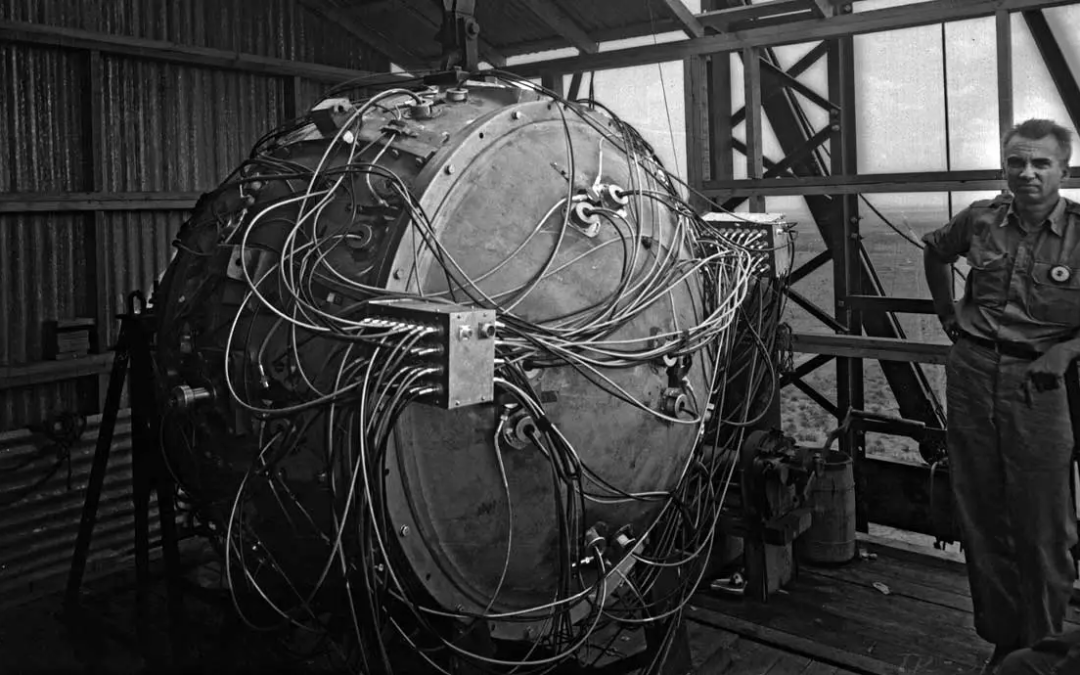Abstract
“Now I am become death, the destroyer of worlds.” – J. Robert Oppenheimer
The Manhattan Project, one of the most significant scientific and engineering endeavors of the 20th century, culminated in the development of the atomic bomb during World War II. This research article explores the strategic decisions, collaborations, and power dynamics of the Manhattan Project through the lens of game theory. It investigates how the interactions between key stakeholders, including scientists, military leaders, and government officials, shaped the project’s outcome and the subsequent nuclear arms race during the Cold War.
Introduction
The Manhattan Project was a top-secret research and development effort during World War II that aimed to develop the world’s first atomic bomb. It was initiated in 1939 and led by the United States, with the collaboration of the United Kingdom and Canada. The project’s success ultimately resulted in the creation of two atomic bombs, which were used in August 1945 to bring an end to World War II. The Manhattan Project marked a pivotal moment in history, as it ushered in the atomic age and had far-reaching implications for science, technology, and global geopolitics. This article employs game theory to analyze the strategic interactions and decisions of the individuals and organizations involved in the project, shedding light on the dynamics that influenced its trajectory.

The Game Theory Framework
Game theory is a mathematical and conceptual framework that has garnered significant attention in various academic disciplines and practical applications. This analytical tool provides a structured approach for studying strategic interactions among rational decision-makers. By modeling these interactions as “games,” the theory seeks to understand the choices individuals or organizations make when their decisions depend on the actions of others. In the context of the Manhattan Project, game theory helps elucidate the choices made by scientists, military leaders, and policymakers as they pursued the development of atomic weapons.
The Players and their Strategies
- Scientists: Many prominent scientists, including J. Robert Oppenheimer, Enrico Fermi, and Richard Feynman, are the key scientists who played an active role in the development of the atomic bomb. While working on the project, scientists had to make a critical choice between cooperating (continuing their research) or defecting (refusing to work on weapons development). Cooperation was driven by the prospect of significant scientific advancement and the development of the atomic bomb, a groundbreaking achievement. However, ethical dilemmas weighed heavily on some scientists’ consciences, causing them to defect in their own way by expressing reservations about the ethical implications of atomic weaponry.
- Government Officials and Military: High-ranking government officials, such as President Franklin D. Roosevelt and later President Harry S. Truman, and military officials, including General Leslie Groves, played pivotal roles in authorizing and overseeing the project. Their objectives encompassed ensuring national security and considering the potential use of atomic weapons to hasten the war’s conclusion. Similarly, the choices of cooperation and defection were interwoven with other military initiatives, most notably Operation Epsilon. Figures like General Leslie Groves found themselves torn between divergent paths: defecting by seeking alternative methods like capturing German scientists for intelligence, and cooperating, understanding the imperative of swiftly concluding the war. Additionally, had Operation Epsilon succeeded, the military might have preferred defection due to the neutralization of the threat.
Navigating the Project
The Manhattan Project can be viewed as a process with multiple phases, including:
- Project Initiation: The decision to start the project was a strategic one, driven by the fear that Nazi Germany might develop atomic weapons first.
- Research and Development: Scientists made choices about how to allocate resources and prioritize research efforts to achieve a functional bomb.
- Ethical Considerations: As progress was made, ethical questions arose about the use of atomic weapons, leading to debates and decisions about whether to proceed.
- Testing and Deployment: The final phase involved testing the atomic bomb (the Trinity test) and deciding when and where to deploy it.
The Payoff Matrix: Nash Equilibrium and Players’ Strategies
In the complex realm of decision-making, both scientists and military strategists find themselves at a crossroads, confronted with the pivotal choices of cooperation and defection. For scientists, cooperation arises from an innate desire to expand the boundaries of knowledge, whereas military cooperation is forged from a starkly different crucible—the urgency to swiftly conclude conflicts and usher in peace.
But some scientists defect from this cooperative endeavor, grappling with the moral implications and redirecting their efforts to mitigate harm, thereby altering the landscape of scientific progress. Additionally, military strategists face their own set of challenges in navigating the intricate web of warfare. Some choose to defect, redirecting resources and attention towards military strategies such as Operation Epsilon. This strategic maneuver alters the landscape of cooperation, hindering the progress and resource allocation initially dedicated to endeavors like the Manhattan Project
| Scientists Defect | Scientists Cooperate | |
| Military and Govt Officials Defect |
(P,P) Suboptimal Outcome |
(T,S) Suboptimal Outcome |
| Military and Govt Officials Cooperate |
(S,T) Suboptimal Outcome |
(R,R) Nash Equilibrium |
Where,
The payoff structure is defined as R>S>T>P.
R (Reward) = 4 is the highest outcome, meaning players prefer to cooperate and receive the reward rather than any other outcome.
S (Sucker’s Payoff) = 3, is the second-highest outcome, indicating that it’s still better to cooperate and receive a moderate outcome rather than both players defecting and receiving a harsh outcome.
T (Temptation) = 2, is the third-highest outcome, representing the payoff when one player defects and the other cooperates. Temptation is lower than the reward but higher than the sucker’s payoff, reflecting the betrayal temptation.
P (Punishment) = 1, is the lowest outcome, signifying that mutual defection leads to a worse outcome for both players compared to mutual cooperation or even one player defecting.
In this matrix, we work with the assumption that all the scientists are of the same opinion to simplify the complex nuances of the decision-making strategies of numerous individuals of varied opinions.
When either player, i.e., military or scientists defect, it leads to a suboptimal outcome. Scientists defect due to their ethical concerns and their desire to maintain scientific autonomy. They express their concerns, but continue working. This causes the progress to be relatively slower, and there are delays in the construction of the atomic bomb. Meanwhile, the military cooperates, leading to scientific advancement (though marred by moral dilemmas) and a swift end to the war due to military cooperation.
Similarly, the government officials face incentives to defect due to their desire to consider other military and espionage initiatives like Epsilon and reallocate resources to them. Scientists achieve scientific progress, but the military faces setbacks due to defection, leading to a delayed end to the war.
When both players defect, the consequences are dire. Scientists’ ethical dilemmas impede the advancement of knowledge, curtailing potential scientific breakthroughs. Simultaneously, the military’s decision to halt progress, especially with the uncertain success of Operation Epsilon, delays the war’s end. This delay not only offers the Axis powers a window to develop their own atomic weapons, altering the global power dynamics, but also raises the specter of other nations acquiring nuclear capabilities in the future. In fact, it is crucial to note that Operation Epsilon did not achieve its primary goal of preventing the Soviet Union from gaining access to scientists like Klaus Fuchs and Ted Hall.
The Nash Equilibrium, represented by mutual cooperation (R, R) in the payoff matrix, signifies the point where both scientists and the military optimize their outcomes by successfully developing the atomic bomb, maximizing their collective benefits in terms of national security and wartime advantage. If scientists choose to cooperate, the military’s best strategy is cooperation as well, and vice versa. Here, defection becomes unattractive for both parties, leading to suboptimal results. Considering the inherent risks associated with defection, particularly evident in slowing down the Manhattan Project, cooperation emerges as the more rational and strategically viable choice. Despite its challenges, it not only secures immediate objectives but also bolsters long-term security, making it the logical and optimal decision in the complex dynamics of the Manhattan Project.
Conclusion
The application of game theory to the Manhattan Project offers a thought-provoking perspective on the strategic decisions, ethical considerations, and power dynamics that defined this historic endeavor. The project’s success hinged on the cooperation between scientists, government officials, and the military, each driven by their distinct objectives and concerns.
In the face of existential threats and moral quandaries, cooperation emerged as the linchpin of success. The Nash Equilibrium, where both scientists and the military opted for collaboration, represented the pinnacle of rational decision-making. This mutual cooperation allowed for the development of the atomic bomb, ensuring national security objectives and hastening the end of a devastating war.
However, this analysis also underscores the fragility of cooperation in the face of conflicting interests. Ethical dilemmas and alternative military initiatives threatened to disrupt the delicate balance, potentially leading to unfavorable consequences. The specter of defection loomed large, promising short-term gains but at the cost of long-term global stability. The lessons gleaned from the Manhattan Project are profound: the pursuit of scientific innovation must be coupled with ethical introspection, and strategic cooperation is paramount in navigating the complexities of an ever-changing world.
In the aftermath of the Manhattan Project, the world entered the atomic age, marked by the Cold War and the nuclear arms race between superpowers. The legacy of this project continues to shape global discussions on the ethics of scientific discovery, responsible scientific conduct, and the management of groundbreaking technologies. Game theory, with its ability to illuminate the dynamics of complex historical events, remains a valuable tool for understanding the choices made by rational actors in the face of profound ethical and strategic challenges.
References
- Manhattan Project: Groves and the MED, 1942. (n.d.).
- Holmes, M. S. (2009, April 20). Spies who spilled Atomic Bomb Secrets. Smithsonian Magazine.
- The Editors of Encyclopaedia Britannica. (2023, September 23). Manhattan Project | Definition, Scientists, Timeline, Locations, Facts, & Significance




Recent Comments